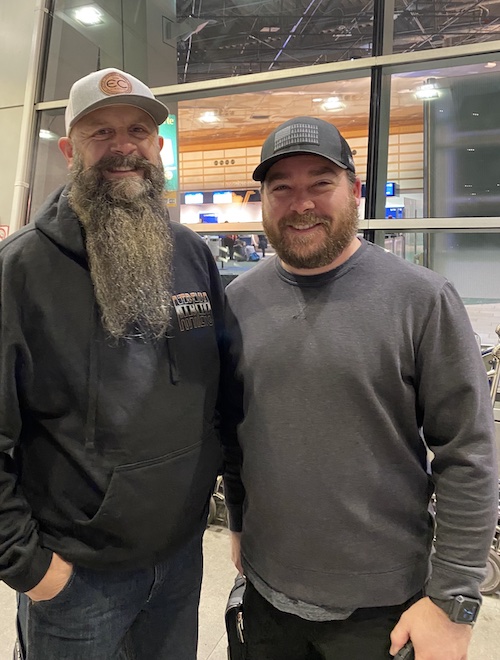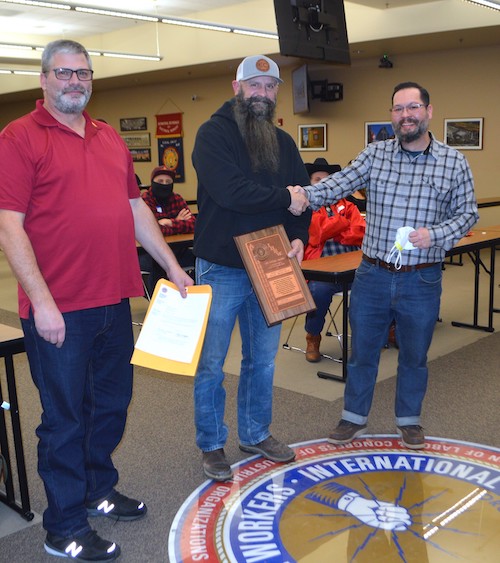One moment they were installing conduit, hunkered down in the concrete moat of a massive building site south of Portland, Ore., earplugs in to minimize the snare-drum racket of the metal decking across the steel I-beams above.

|
| Two Oregon journeymen recently received the IBEW Life Saving Award for their swift actions at risk to themselves after a worksite catastrophe left an Ironworker near death. Keoki Hookano, left, of Tangent Local 280, and Kevin Jorgenson, Portland Local 48, are using their experience to talk about jobsite safety and first-aid training.
|

|
Journeyman Keoki Hookano, shaking the hand of Local 48 President Wayne Chow, receives the IBEW Life Saving Award at the union’s December membership meeting. At left, Business Manager Garth Bachman holds a congratulatory letter to Hookano from IBEW President Lonnie Stephenson. Fellow award recipient Kevin Jorgenson was unable to attend the ceremony.
Photo courtesy of Northwest Labor Press.
|
"The next, journeymen Kevin Jorgenson and Keoki Hookano were in the throes of a nightmare saving a union brother’s life.
“It sounded like an earthquake and a hurricane had hit the building,” Jorgenson said. “I assume now it was the bolts in the roof beams breaking apart. Then I saw Jimmy hit the ground.”
“You could hear and feel it,” Hookano said. “Then Kevin was shouting, ‘Man down! Man down! I turned around and saw a crumpled orange figure.”
The broken, bleeding body of an Ironworker, the man they came to know as Jimmy, lay some 30 feet away. He had plunged more than two stories.
Instincts and training took over as Jorgenson and Hookano flew across the moat, propelling themselves with their dollies.
Their actions and courage in the terrifying minutes ahead that morning in June 2020 have been recognized with one of the union’s highest honors, the IBEW Life Saving Award.
Portland Local 48 presented the awards in December, along with a special Certificate of Recognition for journeyman Sergey Elikh, who assisted other workers in saving a second critically injured Ironworker who broke his back.
“If it were not for the quick response of our members, and lifesaving techniques used, these workers may have had a drastically different outcome,” Local 48 Representative Joshua Carter said. “These members not only acted swiftly to save the lives of these two individuals, but also bravely, because of the unknown dangers still present from the collapsing steel.”
A responding firefighter/paramedic from Tualatin Valley Fire & Rescue said the honor is well deserved. “They definitely put themselves in harm’s way,” Griffin Rojo said. “They dragged the victim out of the danger zone, cut off his harness, and held his C-spine (neck) until we arrived on scene.”
The hazards overhead were first major challenge when Hookano and Jorgenson reached Jimmy and two panicked, uninjured Ironworkers at their fallen brother’s side.
About 60 tradesworkers were on site that day, a public works project being built to state-of-the-art earthquake standards, Jorgenson said.
“One guy says, ‘We’ve got to move him’ and the other one says, ‘Don’t move him!’” he said. “Then the first guy says, ‘Steel is falling!’ We were smack dab in the middle of pick-up sticks.”
The four men cautiously grasped Jimmy’s limbs and eased him onto one of the rolling dollies — a feat complicated by the fact that he was missing a chunk of his right arm and bleeding from the back of his head.
“We got about 150 feet away,” Jorgenson said. “It had rained and there was water on the ground of the moat. There was a solid blood trail in the water a hundred feet long.”
He was unconscious and not breathing, not until his rescuers cut his harness.
“He immediately started gasping for air,” Hookano said. “I had my hand putting pressure on his head. He had orbital fractures. His right arm was pretty much hanging. He had multiple broken ribs.”
He said both injured men had been harnessed to the roof beams, “but when the joint broke, they both slid off.”
Oregon OSHA reported that the accident resulted from a failed connection between a column and a beam due to a lack of welding at the connection.
As Hookano cupped Jimmy’s head, Jorgenson used rags to wipe blood that was pooling in his eye sockets.
Elikh, who was also helping the second man’s rescuers, rushed them an AED — automated external defibrillator. Ironworkers attached the paddles, revealing that Jimmy’s heart rhythm was stable.
“As electricians, we’re trained especially in AED and CPR,” Jorgenson said. “I didn’t know what was going on with his heart, but I knew we needed a reading. The AED itself tells you whether the person needs to be shocked.”
While ambulances were on their way, he said, “everything seemed like it was in slow motion. At the time it seemed like forever before the paramedics got there, but I know it wasn’t.”
The stress on the injured men’s brothers was palpable. “Ironworkers travel as a crew,” Jorgenson said. “They are as close as family, and they were seeing this happen to someone they know personally.”
He knew he had to keep his cool. But after he and Hookano helped medics strap Jimmy to a board and lift him out of the moat, he looked over and saw the Ironworkers’ foreman on the phone.
“Immediately I knew who he was talking to, a call to Jimmy’s wife to tell her what’s going on,” Jorgenson said. “I lost it, because I couldn’t imagine somebody making that phone call to my family.”
The odds for Jimmy, a young father, didn’t look good. As Hookano said, “I’ve seen people die from less.”
In fact, rumor spread a short time later that he’d died in the ambulance. “I didn’t know whether to cry or hold out,” Jorgenson said. The next morning they learned he was alive.
Jimmy spent a month in a medically induced coma, while his tool partner was in a trauma unit after back surgery. According to reports, both men have made remarkable recoveries.
The gravity of the 10:01 a.m. callout nearly two years ago has stuck with employees at TVF&R, even though theirs is the largest, busiest fire district in Oregon. The journeymen’s response is part of that memory.
“The actions of these electrical workers allowed firefighter/paramedics to more quickly assess and treat the victim,” spokesman Peter Scott said.
The rule of thumb when someone is immobilized by injuries is to let medics alone handle them, as the IBEW members and Ironworkers at Jimmy’s side anxiously debated under swaying steel. But in such life-and-death situations, it’s not always possible.
“It’s usually best to wait for trained responders to arrive,” Scott said. “But in this case, the actions of Mr. Hookano and Mr. Jorgenson ultimately helped deliver a positive outcome for the patient.”
For Jorgenson and Hookano, the greatest value of their life-saving awards is the opportunity to put a spotlight on job safety. They say they rarely talk about the day itself.
“I don’t go around telling the story about what we went through when I am talking to people,” Jorgenson said. “It is solely focused on the importance of CPR and first aid.”
Hookano, whose home local is Tangent, Ore., Local 280, said safety instructors are as important as their subject matter.
When he worked on a tech giant’s project in Eastern Oregon, he said, “they had a guy come out there who was probably one of the best CPR teachers I’ve ever had. This guy made it personal, had everybody else make it personal, and now everybody’s invested in it.”
Both men also stress that more accountability and transparency from investigators and employers is critical.
“When I’m talking about safety, it’s also the importance of shutting jobs down, so we can all reevaluate what’s going on after an accident,” Jorgenson said.
They are frustrated not to know more about the official report, saying all parties —builders, contractors, unions, and the industry — need to understand what happened and why.
What they do know is that they’d respond again without hesitation.
“My dad was a firefighter. He ran toward danger,” Hookano said. “He was always the first person to stop if someone needed help. He kind of drilled that into us. I’d do it again, for anybody.”
Wrestling with PTSD after the incident, Jorgenson spoke a lot with his own father.
“The more I talked, the better it got it,” he said. “My dad asked me, ‘Looking back, is there anything you’d do differently?”
“I said, ‘No, nothing. I know we did everything the way we were supposed to do it.’”